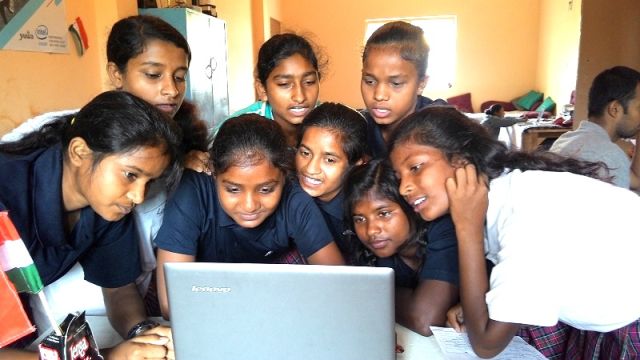
by Editor | May 25, 2021 | Opinions

For representational purpose only (google image)
By Swagata Yadavar,
If a girl in India studies for 12 years or more — till the age of 18 — she is less likely to have teenage pregnancy, less likely to have shorter interval between children and less likely to have more than two children during her lifetime, according to the latest national health data.
A woman with 12 years or more of education has her first child at the median age of 24.7, which is 3.7 years more than the median age of first pregnancy (21) for women between 25-49 years, according to the National Family Health Survey, 2015-16 (NFHS-4) report.
Almost one-third or 33.6 per cent of India’s population is born of adolescent pregnancies; delaying the onset of child bearing could reduce India’s projected 2050 population of 1.7 billion by more than a quarter.
If a woman studies for 12 years or more, she has an average of 2.01 children, compared to 2.2 for all women and 3.82 for women with no education, based on the mean number of children born to women aged 45-49 — a period that marks the end of a woman’s fertility.
“Postponing first births and extending the interval between births have played a role in reducing fertility in many countries,” said the NFHS-4 report.
The total fertility rate for women — the number of children she will have in a lifetime — between 15-49 years is even lower at 1.71 for women with more than 12 years of education compared with 3.06 to women with no education and 2.2 for all women.
“Education is the best contraceptive pill,” said Poonam Muttreja, executive director, Population Foundation of India, an advocacy working on family planning.
There is enough global evidence showing that educating women can reduce the fertility rate of countries, Muttreja said. “Now, national evidence also points that educating women can be a good population control strategy.”
Only four per cent of women with 12 years or more of education have teenage pregnancies compared with eight per cent for all women and 20 per cent for women with no schooling.
Child bearing at a very young age is associated with increased risk of complications during pregnancy and childbirth and higher rates of neonatal mortality.
Children born to educated mothers have higher chances of survival; under five mortality — deaths per 1,000 live births of children under five — of children whose mothers had no schooling was 67.5 while it was less than half (26.5) for children of mothers who had more than 12 years of schooling.
A woman with more than 12 years of education waits three years (35.7 months) to have another child, compared to 31.3 months for women with no schooling.
Birth intervals of less than 24 months can harm newborns and their mothers, causing preterm births, low birth weight and death.
Only 21.5 per cent women aged 15-49 had studied for more than 12 years, compared to 29.6 per cent of men.
In 2017, only one in five adolescents — 14 to 18 years — had completed eight years of schooling and by 18, some 32 per cent females are not enrolled in schools against 28 per cent males, according to the latest Annual Survey of Education Report.
(In arrangement with IndiaSpend.org, a data-driven, non-profit, public interest journalism platform, with whom Swagata Yadavar is principal correspondent. The views expressed are those of IndiaSpend. Feedback at respond@indiaspend.org)
—IANS
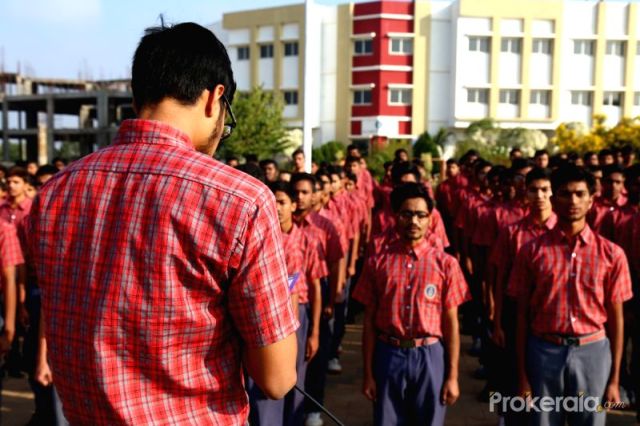
by Editor | May 25, 2021 | Entrepreneurship, Social Entrepreneur, Startup Basics, Startup Financing
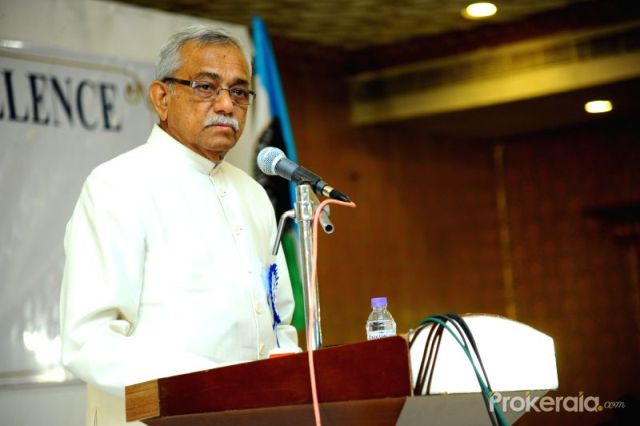
Ghiyasuddin Babukhan, chairman of the Hyderabad Zakat and Charitable Trust.
By Mohammed Shafeeq,
Hyderabad : One of the five pillars of Islam, “zakat” is mandatory charity for every well-to-do Muslim. And Hyderabad Zakat and Charitable Trust (HZCT) has shown how this obligatory form of charity can be channelised to bring change in society through education.
With this noble goal, the 25-year-old organisation has been using “zakat” to pull the community out of illiteracy and today more than 24,000 students study in its 106 schools.
The trust made a humble beginning in 1992 when Ghiasuddin Babukhan, a reputed businessman and philanthropist of this city, with some friends and other like-minded people came together to pool their “zakat” for education. “It started with total ‘zakat’ of just Rs 11 lakh,” recalled HZCT chairman Babukhan while talking to IANS.
With a firm belief in “empowerment through education and freedom through knowledge”, Babukhan and his friends formed a network of schools for poor, mostly in remote villages.
Though these Urdu-medium schools were taken over by the government under the Sarva Shiksha Abhiyan, the trust continues to monitor their functioning, appoint teachers, distribute free uniforms and books.
What started with a total “zakat” of just Rs 11 lakh has now expanded to an annual budget of Rs 12 crore and has touched the lives of over a million people in the last two-and-a-half decades, including poor students, orphans and widows in Telangana, Andhra Pradesh, Maharashtra and Karnataka.
Every Muslim whose assets reached “nisab” or minimum value (the current market price of 60.65 tolas of silver) has to pay 2.5 per cent annual Islamic tax on his wealth.
“People donate without any hassle. I don’t know 99 percent of the donors. I have never met them. We have ensured total transparency. No questions are asked except positive feedback from the donors. Some people come personally to donate huge amounts,” said Babukhan.
“I don’t know whether there is any trust of this size and calibre in India,” he added.
HZCT runs its activities professionally as it has 40 dedicated volunteers and a well-paid, full-time staff. It ensures transparency by publishing annual reports for the donors. Education accounts for over 70 percent of the trust’s spending of Rs 107 crore since its inception.
The trust is spending more than Rs 2.5 crore on schools alone and this includes salaries, uniforms, and “Gems of the Nation” cash awards of Rs 10,000 each to girl students who secure 9.3 GPA or above in the 10th Grade.
What is interesting about these schools is 70 percent of the students are girls. The pass percentage is 92 against the average of 57 in government-run schools.
“Our schools are a success story, not because I am handling it, but because Allah is handling it. For other works there can be several hurdles, but nobody can stop us in the area of education,” he said.
“More than 200,000 students have so far passed out of our schools and many have become professionals like doctors and engineers,” said Babukhan.
In 1996, Foundation for Economic and Education Development (FEED) was formed to run the institutes established by the trust. FEED set up the Hyderabad Institute of Excellence (HIE) in 2013 to hone the skills of meritorious students from poor and needy families to groom them as leaders with a strong sense of dignity, integrity, love for the country, and deep religious values.
Spread over 120 acres at Vikarabad near Hyderabad, this residential school boasts of world-class amenities and state-of-the-art infrastructure, providing education from 6th to 12th Grade. About 50 per cent of the students at HIE are on annual scholarship of Rs 2 lakh each.
It also prepares students for various competitive exams like IIT-JEE Mains and Advanced, National Eligibility cum Entrance Test (NEET), Birla Institute of Technology Science Aptitude Test (BITSAT), and entrance exams to Jawaharlal Institute of Postgraduate Medical Education and Research (JIPMER) and the National Defence Academy. In 2017, Hyderabad Institute of Excellence had 100 percent results in the Intermediate (12th Grade) with 13 students scoring above 98 per cent marks.

“The results over the last four years have been excellent as many students got admissions to reputed colleges in different parts of the country and also into IITs and NITs,” said Babukhan, who believes that the environment plays an important role in creating leaders.
The education programmes of the trust have so far benefited about 378,000 students. It now plans to focus on education of orphans.
The trust is providing financial aid to 10,000 orphans for education from school level to professional courses.
This year it disbursed Rs 1.60 crore for an orphan scholarship programme. It also spent Rs 1.70 crore for distribution of foodgrain, Iftar packs and clothes during Ramadan to about 4,000 widows and orphans and also for distribution of “zabiha” meat.
Other works undertaken by HZCT include relief activities during the Gujarat riots and earthquake, and the Kashmir earthquake and floods.
In 2016-17, HZCT spent Rs 5.57 crore on scholarships for professional courses, orphans and physically handicapped, Rs 1.75 crore on welfare schemes like feeding the poor, Rs 0.25 crore on remarriage of young widows, and Rs 0.12 crore on drinking water and borewells.
(The weekly feature series is part of a positive-journalism project of IANS and the Frank Islam Foundation. Mohammed Shafeeq can be contacted at m.shafeeq@ians.in)
—IANS

by Editor | May 25, 2021 | Corporate Jobs, Economy, Employment, Entrepreneurship, Government Jobs, News, Politics, Private Jobs, Startup Basics
 Gandhinagar : Universities should give top priority to preparing students for employability, President Ram Nath Kovind said on Sunday, lauding Gujarat University for helping many new entrepreneurs through its programmes.
Gandhinagar : Universities should give top priority to preparing students for employability, President Ram Nath Kovind said on Sunday, lauding Gujarat University for helping many new entrepreneurs through its programmes.
Addressing the varsity’s 66th convocation, he said: “Gujarat University is supporting many new entrepreneurs through its Start-up and Entrepreneurship Council.
“The creation of the Council of Skill Development is also a welcome step towards empowering students. Today’s universities should give top priority to preparing their students for employability, and for self-employment and entrepreneurship.”
The President said that there are many good institutions in Ahmedabad that promote a start-up culture.
Also noting that recently, the Prime Ministers of India and Israel inaugurated the International Centre for Entrepreneurship and Technology – or iCreate – in Ahmedabad, he said that this will provide world-class facilities to young Indian entrepreneurs and urged students of Gujarat University to take advantage of them.
—IANS
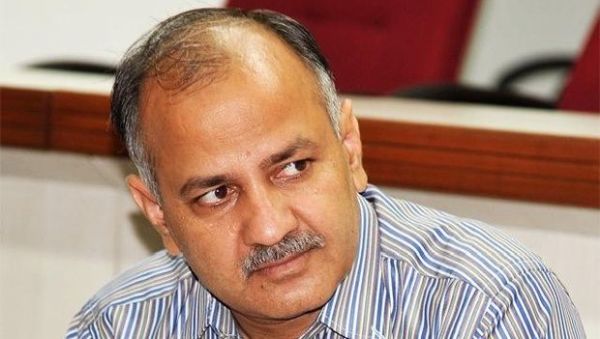
by Editor | May 25, 2021 | News, Politics

Manish Sisodia
New Delhi : Delhi Education Minister Manish Sisodia on Monday said the solution to the menace of terrorism and global warming will be found through education only.
“The time has come when all Education Ministers put their heads together to assure the country that they will bring a solution to terrorism through education,” Sisodia said while addressing the 65th meeting of Central Advisory Board for Education at Vigyan Bhavan here.
He said the Ministers should assure the country that they will impart such education to children that ensures that no educated individual under any circumstances chooses terrorism.
Sisodia lauded the central government for focusing on ‘learning outcomes’ across the country.
At the same time, he said that learning outcomes cannot be achieved by merely drawing up such lists.
He asked on National Council of Educational Research and Training, Central Board of Secondary Education and all state governments to promptly reduce syllabi in all subjects by 50 per cent so that teachers shift their attention to learning outcomes.
“As long as the sword of syllabi completion hangs over teachers they can never shift their attention to learning outcomes,” he said.
Sisodia said the Delhi government was speeding up the process of installing closed-circuit televisions in every classroom of state-run schools and to provide all teachers with tablets.
—IANS
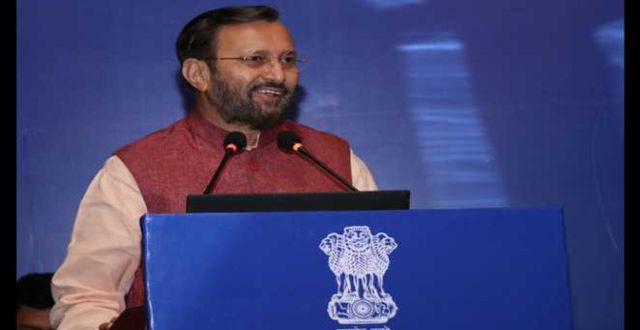
by Editor | May 25, 2021 | Corporate, Corporate Reports

HRD Minister Prakash Javadekar
New Delhi : The HRD Ministry om Monday released the National Achievement Survey report conducted in November last to assess the level of learning of students of Classes 3, 5 and 8.
The survey was conducted on 2.2 million students from 110,000 schools across India.
Speaking at the report launch, Human Resource Development Minister Prakash Javadekar said the survey results will be used to devise educational plans for school students at all levels.
“The inferences will be used to design classroom interventions meant for all schools in various districts. The findings will help understand the efficiency of the education system.
“The survey results will help guide the education policy, in planning and implementation at the national, state, district and classroom levels for improving learning in children and bringing about qualitative improvements,” Javadekar said.
Emphasising the role of technology in education, he said the government will try to install digital blackboards in all schools in the next five years.
The survey data can be accessed on the MHRD website.
—IANS






